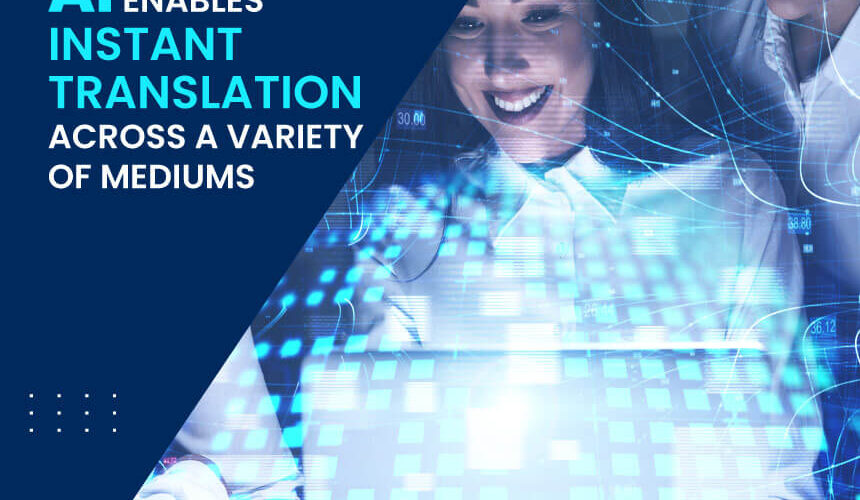Human-machine interaction has advanced dramatically, thanks mainly to artificial intelligence (AI). AI has become a seamless part of our daily life, from smart homes to self-driving automobiles. And AI, when used to translate text or speech from one language to another, is assisting in the dismantling of one of the most significant barriers between humans on the planet: language.
These technical advancements, most notably in language translation, rely heavily on voice interactions. Artificial Intelligence in translation spreads across multiple mediums, including text, audio, graphics, and even street signs. AI can now manage massive volumes of text or speech that require translation.
The system works by detecting individual words and then drawing on commonalities in how different languages communicate relationships. This capacity is then bundled into a smartphone app, such as Google Translate or integrated into a website like Facebook for on-the-fly text translation.
The applications for artificial intelligence in translation technology are vital and impactful, increasing experiences like being a customer with an international firm (by improving understanding between the company and the customer) and allowing research and information interchange. Now that AI translators are widely available, traveling to another country where you don’t speak the language will be considerably more manageable.
Language Translation Tools Examples
Many large IT companies have created their artificial intelligence in translation software. Although Google Translate is the most well-known, Microsoft’s Translator program is a strong contender.
According to Facebook’s translation tool, convolutional neural networks (CNNs) are better than recurrent neural networks (RNNs) in handling contextual components of language.
Furthermore, several global programs, such as the Makshane project, which develops translation models for African languages, focus on enhancing and expanding AI-driven language translation.
How do Artificial Intelligence In Translation Techniques Work?
Online language translation began in the 1990s with two essential products: AltaVista’s Babelfish and Xerox’s Systran. These early web translation programs could handle short chunks of text by employing statistical methods.
However, we now have to deal with massive amounts of data, necessitating a different strategy rapidly. Neural machine translation is a deep learning technique used in today’s artificial intelligence in translation.
Based on artificially built neural nets, this method translates entire sentences instead of single words, making it faster and more accurate. With NMT, AI can learn from previously completed translations, picking up on word usage, phrase structure, and intent depending on context. This methodology is far more effective than earlier methods since it uses less memory and data to operate. All translations are linked together, providing better context and accuracy for vast volumes of speech or text.
Artificial Intelligence’s Advantages In Language Translation
The use of AI-driven language translation tools has several advantages. It can provide instant results in various languages, such as Google Translate or Facebook’s built-in translation capability.
These tools are included in the websites we visit daily. Interacting with international products, services, and people brings increased convenience and a more streamlined experience.
Furthermore, AI-driven language translation software is usually free and available to anyone with an internet connection and a computer or smartphone. Many tools are now available offline, providing additional options for traveling or conducting business in locations where internet connections are less stable.
Language translation tools powered by artificial intelligence is quickly improving speed and accuracy. Can it, however, compete with human translators?
Critical Issues With AI-Assisted Language Translation
For all its glitz and gloss, deep learning is not without its drawbacks. Accuracy has traditionally been a significant challenge in language translation, and it is no different in the field of AI. It’s even more crucial in this case.
In an interview with Wired Magazine, Google researchers honestly discussed some of these shortcomings. They also pointed out that simply increasing the size of the neural network and adding more data does not guarantee that it can imitate human abilities.
NYU researcher Gary Marcus labeled deep learning as “greedy, brittle, opaque, and shallow” in the same article. In his comment, the word ‘greed’ relates to how neural networks require massive amounts of training data.
It’s a huge challenge in and of itself to find, gather, and sanitize all of that data, but it’s vital. Better data leads to better translation models, which are necessary for providing correct results to the end-user.
Another challenge with artificial intelligence in translation is the unavoidable requirement to supplement machine translation with human input, at least to some level. This scenario has just lately begun to alter, with the human touch frequently required to attain adequate levels of precision.
Another issue in translating data-poor languages like Yoruba and Malayalam is finding and gathering enough training data to feed a hungry neural network.
Towards A Higher Standard Of Translation
Despite its current thorny issues, artificial intelligence in translation has improved dramatically in recent years. However, there are still areas where improvements might be done. One of the most important things here is to improve the quality of AI training data, such as by supplying carefully annotated datasets.
Machine translation datasets of bilingual pairings can be sourced, translated, and validated using DefinedCrowd’s patented translation methods with human translators. These datasets can train, develop, and evaluate baseline models for AI-driven language translation projects, enhancing accuracy in the target languages. Furthermore, because our datasets cover many languages, you can broaden your translation horizons by training with additional language pairs.
Conclusion
Artificial Intelligence in language translation tools has enormous potential when only the highest quality raw ingredients are used.
Are you ready to boost the performance of your machine translation engines? Here you can learn more about our translation workflows.
To know more about artificial intelligence in translation business, contact ONPASSIVE.
Source link




